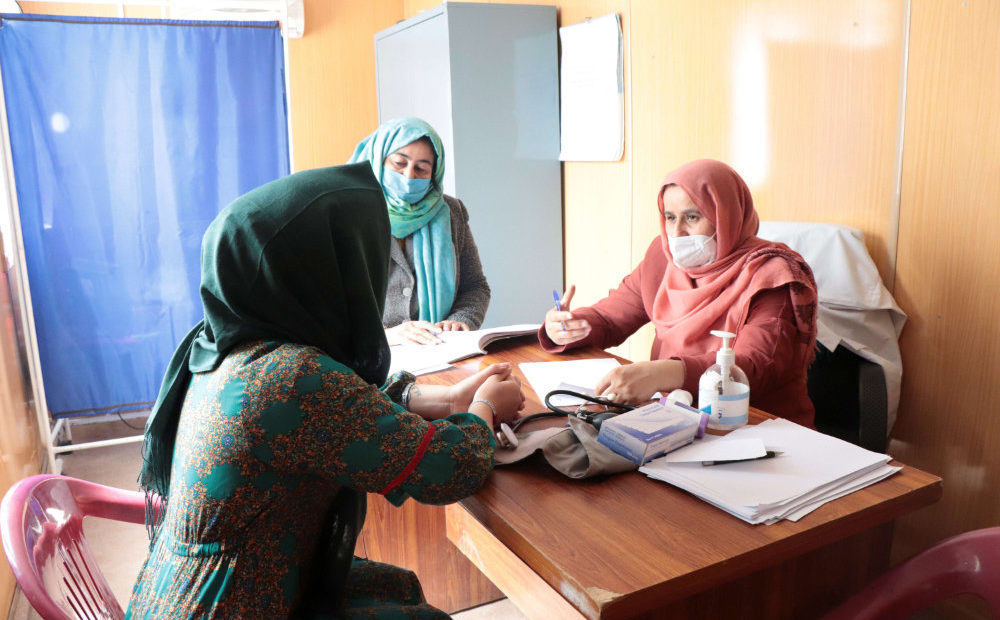From frontline female combatants with the People’s Defence Force in Myanmar to queer Syrian refugees living in displacement in Lebanon, from seasonal workers on the factory floor of textile companies in Bangladesh to adolescents vulnerable to early marriage to fighters of armed groups in Somalia, the need of sexual and reproductive health and rights (SRHR) is ubiquitous, stark and often gendered in various humanitarian settings. It concerns a wide range of issues, including fertility, maternal and child health, menstrual health, contraceptive service and safe abortion as well as prevention and treatment of HIV and STIs, and sexual and gender-based violence (SGBV) services.
In this post, MSF Humanitarian Affairs Analyst Peixuan Xie examines the gendered nature of SRHR needs and progressive potential of leveraging feminist methods for inclusive SRHR in humanitarian assistance and in post-humanitarian transition, arguing that feminist analysis could help unveil the continuum and power dynamics of SRHR deprivation and that the fulfilment of SRHR by concerted humanitarian efforts aides the realization of human security, inclusion and bodily autonomy.
In spite of various academic and practitioner accounts highlighting the acute relevance of sexual and reproductive health and rights (SRHR) before, during and after armed conflict and in other humanitarian settings, the pioneering realization of SRHR as a humanitarian issue, as reflected in the Inter-agency Minimum Initial Service Package (MISP) for example, is not yet matched with action. A common argument contends that SRHR is more of a development issue beyond the principal remit or the time scope of humanitarian action. This disconnect reveals a critical opportunity missed as SRHR programs have the potential to strengthen rights-based empowerment, instead of reinforcing narratives of passive victimization, in humanitarian action. Integrating SRHR, with feminist methods, in humanitarian work would necessarily push external actors to reckon with gendered power relations and link with existing local mechanisms; in many cases, these mechanisms bridge the access to otherwise unreachable populations, which further contributes to impartial assistance to those most in need.
SRHR in humanitarian settings
According to the definitions of UNFPA, the UN agency most dedicated to sexual and reproductive health (SRH), this category of health services encompass a broad range of issues including but not limited to comprehensive sex education, menstrual health, maternal health, contraceptive service and safe abortion, prevention and treatment of HIV and STIs, sexual and gender-based violence services, and information, counselling and services for sexual health and well-being.
Certainly, these needs exist in all kinds of environments; in humanitarian settings, such as armed conflict, natural disaster, public health crises and mass displacement, they are often amplified. WHO recorded the worst maternal mortality ratio per 100,000 live births in conflict-affected countries: 1,150 in South Sudan, 1,140 in Chad, 829 in the Central African Republic, and 829 in Somalia. In Nepal and Bangladesh, humanitarian organizations also noticed the increased number of clients seeking SRH services after natural disasters.
Gender intersects with institutional and infrastructure obstacles in the process. UNFPA estimated in 2021 that 35 million women of reproductive age, including 4.8 million pregnant women, required humanitarian assistance for reasons related to conflict and natural disasters. A 2023 report on SRHR in displacement and humanitarian response in Lebanon documents in detail the multi-faceted SRHR barriers facing refugees and displaced persons of various identities, including socioeconomic destitution, social taboos around sex and intimacy, and discrimination and stigmatization based on gender and sexual orientation.
These accounts demonstrate that the relevance of SRHR in emergency settings goes well beyond a sole focus on women and girls or on sexual and gender-based violence – it is about informed and autonomous reproductive decision-making for everyone, as embedded in the SRHR provisions in the Convention on the Elimination of All Forms of Discrimination Against Women (CEDAW) and the International Covenant on Economic, Social, and Cultural Rights (ICESCR). Comprehensive SGBV responses should address a whole continuum of more structural violence resultant from health as well as social, political and gender inequalities.
The systematic use of rape as a means of warfare, which is often the focus in humanitarian action in armed conflict, is but one reflection of such inequalities, power imbalance, and often dominance, along with other non-rape reproductive violence. Integrating other SRHR funding and programming ensures that survivors of other forms of SGBV obtain needed services. For instance, in areas controlled by armed groups in Rakhine, MSF continues to deliver SRH services alongside support of survivors of sexual violence; in other regions across Asia, its thematic coverage extends to interventions on child marriage, adolescent SRH, and occupational health including SRH.
Just as importantly, the attainment of SRHR, especially in contexts of manmade or natural disasters, bears pronounced relevance for not just relief and recovery, but also positive peace (as opposed to cessation of war/conflict), human security (as opposed to militarized security), and individual agency actualized through access to critical health services and exercise of bodily autonomy (as opposed to victimization).
Nonetheless, physical and attitudinal hurdles arising from gendered and often racialized barriers are widely reported as preventing the exercise of rights and access to services. Humanitarian actors, then, become important gap-fillers, in accordance with the findings of both humanitarian health politics and feminist peace studies, although not without often implicated positions or limited maneuvering space within legal and political boundaries locally. How could the humanitarian movement, often also tied to principled commitment to humanity, neutrality and impartiality, deliver SRH services in a manner that acknowledges and addresses barriers and underlying exclusionary norms and discrimination? Gaining accumulative recognition in the crossroad of global health politics and peace research, feminist methods present a crucial avenue.
Feminist approach to SRHR
To be sure, ambitious standards (the MISP, inter alia) are in place for inclusive and equitable humanitarian SRH services that “address gender and power dynamics” with respectful partnership with people from varied age, sex, gender and gender identity, marital status, sexual orientation, location, disability, and racial backgrounds. A feminist approach to SRHR could direct the implementation of these ambitions, for it is not about women and girls or quotas but rather probes power, discourse and exclusion, and connects them with broader feminist reformative efforts in international relations, peacebuilding and security governance.
Distinct feminist perspectives emerge out of a deep scepticism of traditional knowledge and challenges the often unseen androcentric or masculine biases in the way that knowledge has traditionally been constructed. As the masculinization of everyday health needs is seen to be normalized in global health politics, needs that fall out of the masculine-normal category risk being feminized, marginalized and eventually dismissed. The feminist approach thus lends its particular relevance for asking the questions of what SRHR counts, what doesn’t, of whom, and for what underlying, structural reasons. In this vein, the inquiry effectively uncovers any groups and individuals sidelined or silenced in accessing SRH and illuminates the translation of standards into action. In resource-constrained emergency settings, this bears heightened significance for both what aspects of SRHR and which populations should be included to realize the commitments to impartiality and equality.
Here, the burgeoning discussions around fertility, violence against men and queer self-care are exemplary cases for what feminist gender analysis could bring to SRHR in humanitarian settings. Various scholarship have decoded the gendered and racialized problematization of these lines of needs: fertility, for instance, is often considered a matter “to be managed” and heavily subjected to constraints in humanitarian settings, complicated by assumptions that crisis-affected people ‘should not, or could not, possibly want to have (more) children’; queer needs, similarly, are often stigmatized, with community members pushed to resort to self-organized and in some cases clandestine support, compounding vulnerabilities and further risks of exposure; interventions on SGBV that are not grounded in the socio-economic, political and cultural reality of Rohingya displacement risks assigning generic and dichotomous profiles to men/women, reducing gender-based violence to individual or collective behaviours of a specific group, and eventually blurring the root causes and norms of violence.
Asking the questions of where, whose, and what needs hence helps reconceptualize SRH equity and shed light on the continuum of service deprivation, health insecurity and denial of agency while directly speaking to surging contestations around principled neutrality and impartiality. Criticisms from different ends charge that humanitarian aid, including SRH, is either being distorted by power dynamics embedded in local political ecology or SRHR itself co-opted by the presence of humanitarian actors imposed with Western agendas. These sustained contentions have brought about vibrant discussions, most remarkably, on whether good humanitarians must be neutral and on a rights-based approach to humanitarian assistance. In the SRH sphere, studies illustrate that when gender is a social determinant of health but is not addressed in the health system, it risks reinforcing often restrictive norms, inequities and inequalities within health systems and in society.
Even with all its operational and ethical constraints, the humanitarian sector cannot afford neglecting these dynamics. Feminist approach is well-posited to break the arbitrary demarcation between neutrality and impartiality and between the Western and the local and coordinate impartial and equitable scrutiny of discrimination, marginalization, and exclusion across spectrums. Connecting the approach to the broader movement of feminist peace, it also points to greater paradigm leverage of medical humanitarianism if synergized with health rights-based positive peace and human security. Humanitarian actors therefore need to assess these barriers, discrimination, marginalization, and exclusion.
Implications for humanitarians
In practice, how does humanitarian SRH go gender-transformative, especially in the face of constraining state regulations or the absolute dismantling of governance and rule of law, both scenarios being explicitly present in many humanitarian settings? This post argues that the joined forces of the humanitarian agenda with broader gender/feminist instruments and synergy with local feminist humanitarian mechanisms are sound starting-off points.
Humanitarian actors should not shy away from participating in the reflection and practice of coordinating with existing instruments under, for instance, the Women, Peace and Security agenda that governs all aspects related to gender in peace and conflict or the CEDAW General Comments on reproductive choice (No. 16) and on armed conflict and humanitarian emergency (No. 19 and No. 35). Albeit with “rather porous borders” and the need to “change to address new problems”, these mechanisms are more constantly injected with most relevant feminist issues and thoughts. Incorporation of humanitarian perspectives could brew mutual enhancement in terms of policy robustness and networks of accountability. Such joined forces mobilize the often less-attended humanitarian or SRH dimensions of feminist paradigms as much as it eases the “tyranny of the urgent” in humanitarian action that prevents the consideration of gendered equity and justice. The inclusivity of SRHR as an entry point, in particular, contributes to countering existing victimization narratives and a shift towards one of autonomy and empowerment. Some NGOs are seen to engage with the intersections of SRHR and these peacebuilding/rights instruments. They could be identifiable champions for other humanitarian actors to join the process.
Critically, leveraging gender instruments and emerging epistemological trends at institutional level for humanitarian SRH increases bargaining power with the state. Indeed, even with their privileges and immunities, humanitarian operations must respect national laws and cooperate with national healthcare systems. This modality determines humanitarians cannot always provide most needed services to most targeted populations. However, often times state obligations under their ratified treaties or universally adjudicable international instruments are broader than under IHL or domestic frameworks. Mobilizing these expansive regulations diversifies the channels through which humanitarians could enter negotiations with states. Amid political crises, the application of additional instruments also eases the possible pitfall of an overly state-centric approach—humanitarian assistance can be subjected to abuse and other actors would be politicized.
Engagement with women’s rights and security processes also presents a bridge to on-the-ground civil society mechanisms. Grassroot women’s organizations are often first responders of SRH in humanitarian settings, in many cases connecting social networks for humanitarian preparedness and providing essential services to different groups and communities before international humanitarian actors would have access, so their equal participation to humanitarian processes could be an effective avenue for locating those most in need with gender sensitivities and paving the way for restoring post-humanitarian services delivery including SRH. This path of transition speaks to the concern that aid organizations could sustainably fulfil the role of de facto substitute for the public health sector, as is the case in Afghanistan. A recent study also demonstrates how in Myanmar local human rights organizations are also undertaking humanitarian work by providing direct assistance to communities alongside their documentation work. For humanitarians to uphold their witness-bearing responsibility, correspondence with these organizations can be crucial.
Author’s note: This post represents the personal views and opinions of the author and does not necessarily reflect the positions or opinions of any organization, institution, or individual with which the author is affiliated.
See also:
- Megan O’Brien, Online violence: real life impacts on women and girls in humanitarian settings, January 4, 2024
- Sandra Iman Pertek, Ahmed Al-Dawoody, Sexual and gender-based violence in migration contexts: does faith sensitivity matter?, September 21, 2023
- Ariana Lopes Morey, What does ‘back to basics’ mean for gender and the fundamental principles?, September 1, 2022






Comments